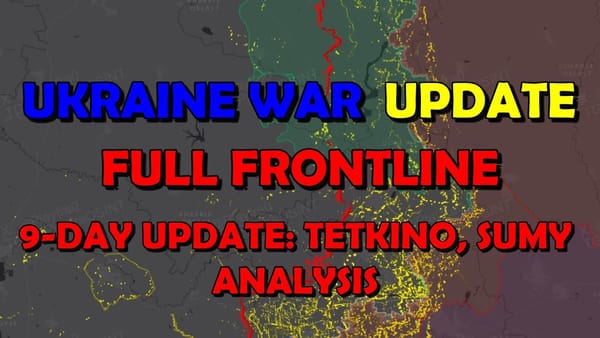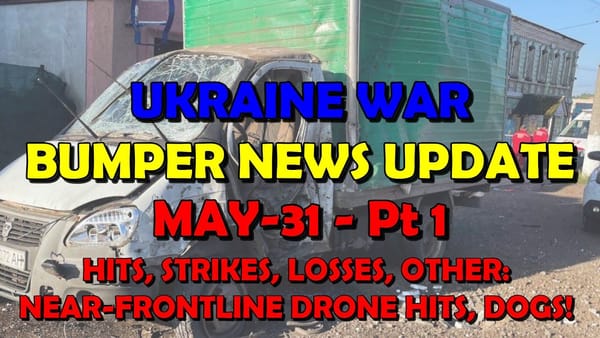Ukraine Conflict: Full Frontline Update
"They just see, I think, human value slightly differently to maybe how I would."
30/03/2024
Hello Team
00:00-00:19⏩Jonathan welcomes viewers to the daily frontline update and thanks JR for the mapping. He reminds viewers to refer to the key on the map if needed.
Return to top⤴️
Ukrainian Fortifications
00:19-06:45⏩Jonathan discusses the criticisms levelled at Ukraine for the lack of fortifications in some areas, particularly west of Avdiivka, which fell to the Russians. He suggests that the Ukrainians were expecting continued success in their offensive operations and didn't foresee the need for such defences. Jonathan notes that the lack of fortifications in the south, where Ukrainian forces planned to advance quickly, was understandable as they did not expect to be fighting defensively in those areas. He highlights the delays and confusion in the initial stages, with questions arising over whether the central government or private enterprises should fund the fortifications. Jonathan mentions that while some regions like Zaporizhzhia were able to finance their own defences, others like Donetsk and Luhansk, with less financial capacity, faced challenges. He acknowledges the eventual centralisation of the fortification efforts but suggests that in some areas, this came too late. Jonathan highlights the significant fortifications now in place, particularly in Zaporizhzhia, showcasing the effort invested in building tank ditches, dragon's teeth, prefabricated concrete structures, and tunnels. He emphasises that these defences are based on the Russian model, which while often ridiculed, do pose an obstacle to advancing forces. Jonathan provides specific figures for the scale of fortification work, citing over 42 kilometers of anti-tank ditches in the Dnipropetrovsk region and more than 11,000 dragon's teeth installed. He explains the strategic reasoning behind the design, such as the zigzag pattern of trenches to hinder aerial bombardment. Jonathan also notes that Kyiv region has constructed 10,000 concrete pyramids to strengthen its defences.
Return to top⤴️
Russian Assault Tactics
06:45-09:45⏩Jonathan shares an anecdote from a Polish soldier fighting with the International Legion in Ukraine, describing Russian assault tactics. The soldier describes a three-wave system employed by the Russians:
- "The Sheep": Poorly trained, ill-equipped conscripts are sent in as a first wave to draw out Ukrainian fire and reveal defensive positions. These troops are considered expendable and typically carry only enough ammunition for a short engagement.
- Reconnaissance Wave: A second wave with a few better-equipped and trained soldiers follows, their objective being to further probe Ukrainian defences and relay information.
- Elite Troops: The final wave comprises the most experienced, well-equipped Russian soldiers, often Wagner fighters, tasked with exploiting the intelligence gathered from the previous waves and engaging in a decisive assault.
Jonathan acknowledges the anecdotal nature of this account, but draws parallels to reports from Bakhmut, where a similar pattern of using convicts as cannon fodder to pave the way for elite units was observed. He concludes that this tactic, while brutal, does provide the Russians with valuable intelligence and a tactical advantage.
Return to top⤴️
Belgorod Shelling and Ukrainian Focus
09:48-10:49⏩Jonathan reports on the closure of Russian schools in Belgorod, near the Ukrainian border, due to shelling, and the planned evacuation of children from the region. He interprets this as an indication that Ukrainian forces are intensifying their focus on Belgorod Oblast, targeting it as a key staging ground for Russian attacks on Kharkiv. Jonathan suggests that by neutralising military installations in Belgorod, Ukrainian forces aim to reduce the threat to Kharkiv.
Return to top⤴️
Kupyansk, Svatove, Kreminna Frontline
10:49-11:47⏩Jonathan observes that the frontline from Kupyansk to Svatove to Kreminna remains stable with no significant changes. He notes that despite long-standing rumours of a major Russian offensive in this sector, the situation has remained relatively static. Jonathan cites reports from other military analysts, such as Andrew Perpetua, suggesting a recent decrease in activity in the area, particularly around Bilohorivka. He speculates on the reasons for this lull, pondering the potential depletion of Russian resources or a change in strategy.
Return to top⤴️
Ivanivske Update and Russian Tactics
11:47-13:30⏩Jonathan discusses the situation in Ivanivske, noting a discrepancy between different sources regarding the level of Russian control. He highlights that while pro-Russian sources claim complete control, others suggest the Ukrainians still hold positions within the town. Jonathan cites reports, albeit unconfirmed, suggesting Ukrainian forces have destroyed basements in Ivanivske to deny Russian troops cover from artillery and drone strikes, rendering the area a highly dangerous "kill box". He explains that this tactic, while denying both sides a foothold, makes holding Ivanivske strategically less important. Jonathan argues that the higher ground north of Ivanivske holds more strategic value than the town itself, as it provides a vantage point for controlling the road into Ivanivske and surrounding areas. He posits that even if Russian forces advance into the town, their control would remain tenuous due to Ukrainian drone activity and the exposed nature of the terrain.
Return to top⤴️
Southern Bakhmut Frontline Update
13:30-14:46⏩Jonathan reports no significant changes in the southern Bakhmut sector, with the frontline remaining largely static. He highlights the lack of Russian progress around Klishchiivka and Kurdyumivka, attributing this to the effectiveness of Ukrainian defences. Jonathan does note some Russian advances around Pervomaiske, where they have filled in the "grey zone" and pushed further south. He acknowledges that the Russians now control a significant portion of Pervomaiske, having pushed Ukrainian forces back towards Natlyaivka. He observes that this Russian progress in Pervomaiske has been facilitated by their earlier successes in capturing Tonenke, highlighting the interconnected nature of operations in this sector.
Return to top⤴️
Ukrainian Defensive Preparations and Eyewitness Account
14:46-17:26⏩Jonathan pauses his analysis to share a message from Pierre de Ponce, a fellow journalist who recently travelled with him to Ukraine. Pierre reports a significant increase in the movement of Ukrainian military equipment, suggesting a potential build-up of forces. Jonathan reads out Pierre's message, which describes witnessing "six truckloads" of dragon's teeth being delivered, indicating a large-scale effort to fortify Ukrainian positions. Pierre further notes "extensive fortifications being built" in the Izyum-Kramatorsk and Sversk-Lyman areas. Jonathan connects this information to his earlier discussion about Ukrainian fortifications, suggesting that these defensive preparations are crucial given the ongoing Russian pressure. He speculates that the fortifications could be a sign of Ukraine preparing for a strategic withdrawal, particularly if the anticipated $60 billion aid package from the US is not approved by Congress. Jonathan highlights the four key areas where Russian attacks are expected: the Terny salient, Bakhmut, Avdiivka, and the Mariinka-Krasnohorivka area south of Avdiivka. He ponders the strategic dilemmas facing both sides, questioning where a Russian commander would focus their efforts, and whether Ukraine is preparing for a fighting retreat or digging in for a protracted defence.
Return to top⤴️
Avdiivka, Pervomaiske, and Mariinka Frontline Update
17:26-21:10⏩Jonathan resumes his frontline analysis, focusing on the Avdiivka area. He reports no significant gains for either side but acknowledges continued Russian attempts to push south towards Tonenke. He expects the Russians will encounter stronger Ukrainian fortifications as they move westward. Jonathan revisits the topic of fortifications, attributing the criticism levelled at the Ukrainian military to the absence of defensive lines further south of Avdiivka, which forced them into a fighting retreat, relying on the river and high ground for defence. Moving southwards, Jonathan acknowledges Russian gains in Pervomaiske, noting their control over a significant portion of the settlement. He observes that this advance, facilitated by earlier successes in Tonenke, demonstrates the interconnected nature of operations in the area. Further south, near Nevelske and Krasnohorivka, Jonathan reports some Russian gains north of Staromykhailivka. He cites geolocated footage confirming these advances and suggests that the Russians aim to encircle Krasnohorivka, applying pressure from the north through Staromykhailivka, from the south, and through Mariinka towards Heorhiivka. He notes additional Russian gains in Heorhiivka, confirming reports from various sources. Jonathan concludes this section by focusing on the situation southwest of Donetsk, where he reports Russian advances into the outskirts of Mashynobudivnyk, dachas (summer houses) north of Novomykhailivka, and parts of the forest belt northwest of warehouses in the same area. He notes the intense pressure on Ukrainian forces in this sector, with the Russians making consistent gains, particularly around Novomykhailivka.
Return to top⤴️
Analysis of Russian Offensive Options
21:10-22:58⏩Jonathan poses a thought experiment, asking viewers to consider where they would focus their efforts if they were a Russian commander. He presents four options: the Mariinka-Novomykhailivka area, Avdiivka, Chasiv Yar, or the Terny-Torske salient. Jonathan acknowledges that each option presents its own set of opportunities and challenges. He references Andrew Perpetua's analysis, which suggests that a commander's choice would depend on their risk appetite and strategic objectives. Jonathan shares his own perspective, stating that if he were a Russian commander, he would prioritise the Novomykhailivka area due to its strategic importance and the potential for achieving a breakthrough that could impact the entire frontline. He also highlights the strategic significance of the Terny-Torske salient, particularly the Zhherebets River, which, if captured, would give the Russians control over most of Luhansk Oblast. Jonathan acknowledges the difficulty of predicting Russian intentions, noting that despite their heavy losses, they have shown a willingness to persist with offensives even in the face of stiff resistance. He concludes that while the Russians have struggled to make significant gains in most areas, their persistence should not be underestimated.
Return to top⤴️
Southern Frontline and Wrap-up
22:58-23:32⏩Jonathan concludes the frontline update by reporting no significant changes in the southern frontline and around Kherson. He reiterates that despite the heavy losses incurred by Russian forces, their perspective on human life and military success may differ from Western perspectives, potentially explaining their continued offensives. Jonathan thanks viewers for their support and encourages them to like, subscribe, and share the video. He signs off, promising to return with another update the following day.
Return to top⤴️



